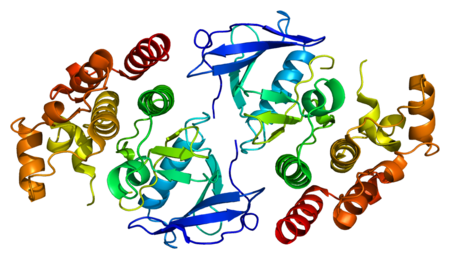BRAF_(gen)


BRAF_(gen)
1UWH, 1UWJ, 2FB8, 2L05, 3C4C, 3D4Q, 3IDP, 3II5, 3NY5, 3OG7, 3PPJ, 3PPK, 3PRF, 3PRI, 3PSB, 3PSD, 3Q4C, 3Q96, 3SKC, 3TV4, 3TV6, 4DBN, 4E26, 4E4X, 4EHE, 4EHG, 4FC0, 4FK3, 4G9C, 4G9R, 4H58, 4JVG, 4KSP, 4KSQ, 4MBJ, 4MNE, 4MNF, 4PP7, 4WO5, 5C9C, 5CT7, 4XV2, 4XV1, 4XV9, 4XV3, 4R5Y, 5CSW, 5CSX, 4YHT, 5J2R, 5FD2, 5HIE, 5HID, 5HI2, 4CQE, 5J18673n/aENSG00000157764n/aP15056n/aNM_004333
NM_001354609
NM_001374244
NM_001374258n/aNP_001365397
NP_001365398
NP_001365399
NP_001365400
NP_001365401
NP_001365402
NP_001365403
NP_001365404n/aBRAF là một gene trong cơ thể người mã hóa cho protein B-raf. Gen này cũng được biết đến là gen tiền ung thư B-Raf và v-Raf chuột ung thư virus sự homolog B,còn protein là serine/threonine-protein kinase B-Raf.[3][4]Các protein B-Raf tham gia truyền tín hiệu trong tế bào do đó có liên quan với điều khiển phát triển tế bào. Năm 2002, nó đã được chứng minh là có đột biến trong một số ung thư.[5]Một số BRAF đột biến di truyền khác gây dị tật bẩm sinh.Các loại thuốc điều trị ung thư dựa trên đột biến BRAF mới được phát triển. Hai trong số các loại thuốc này, vemurafenib[6] và dabrafenib được FDA chấp thuận điều trị của u hắc tố giai đoạn cuối.
NM_001354609
NM_001374244
NM_001374258n/aNP_001365397
NP_001365398
NP_001365399
NP_001365400
NP_001365401
NP_001365402
NP_001365403
NP_001365404n/aBRAF là một gene trong cơ thể người mã hóa cho protein B-raf. Gen này cũng được biết đến là gen tiền ung thư B-Raf và v-Raf chuột ung thư virus sự homolog B,còn protein là serine/threonine-protein kinase B-Raf.[3][4]Các protein B-Raf tham gia truyền tín hiệu trong tế bào do đó có liên quan với điều khiển phát triển tế bào. Năm 2002, nó đã được chứng minh là có đột biến trong một số ung thư.[5]Một số BRAF đột biến di truyền khác gây dị tật bẩm sinh.Các loại thuốc điều trị ung thư dựa trên đột biến BRAF mới được phát triển. Hai trong số các loại thuốc này, vemurafenib[6] và dabrafenib được FDA chấp thuận điều trị của u hắc tố giai đoạn cuối.
Thực đơn
BRAF_(gen)Liên quan
Tài liệu tham khảo
WikiPedia: BRAF_(gen)